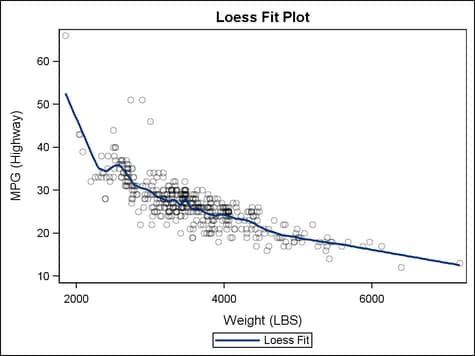Example Program and Statement Details
Example Program
proc template;
define statgraph loessplot;
begingraph;
entrytitle "Loess Fit Plot";
layout overlay;
scatterplot x=weight y=mpg_highway /
datatransparency=.7;
loessplot x=weight y=mpg_highway / name="fitline"
alpha=.05 legendlabel="Loess Fit";
discretelegend "fitline";
endlayout;
endgraph;
end;
run;
proc sgrender data=sashelp.cars template=loessplot;
run;
Statement Summary
The LOESSPLOT statement
only supports statistical models of one independent and one dependent
variable. For more information about the fitting methodology, see
the LOESS procedure in the SAS/STAT user’s guide.
In addition to the loess
curve, the LOESSPLOT statement can compute confidence levels for the
fitted line. To display the confidence levels,
-
use the CLM= option to declare a name for the confidence level of the mean
-
use a MODELBAND statement to refer this name. This statement draws a confidence band from this information. See MODELBAND Statement for information about how to control the appearance of the confidence band.
Loess Regression Options
Options
specifies the color
and font attributes of the curve labels. See General Syntax for Attribute Options for the syntax
on using a style-element and Text Options for available text-options.
specifies the location
of the curve label relative to the plot area.
Restriction: OUTSIDE
cannot be used when the LOESSPLOT is used in multicell layouts such
as LATTICE, DATAPANEL, or DATALATTICE, where axes might be external
to the grid.
Interaction: This
option is used in conjunction with the CURVELABELPOSITION= option to determine where the curve
labels appear. For more information, see Location and Position of Curve Labels.
specifies the position
of the curve label relative to the curve line.
Only used when CURVELABELPOSITION=OUTSIDE.
The curve label is positioned automatically near the curve boundary
along unused axes whenever possible (typically Y2 and X2) to avoid
collision with tick values.
Interaction: The
AUTO setting is ignored if CURVELABELLOCATION=INSIDE is specified.
The START and END settings are ignored if CURVELABELLOCATION=OUTSIDE
is specified.
Interaction: This
option is used in conjunction with the CURVELABELLOCATION= option
to determine where the curve label appears. For more information,
see Location and Position of Curve Labels.
creates a distinct
set of curves from just the observations that correspond to each unique
group value of the specified column.
specifies
a discrete attribute variable that is defined in a DISCRETEATTRVAR statement.
Default: Each
distinct group value might be represented in the graph by a different
combination of color and line pattern. Line colors vary according
to the GraphData1:ContrastColor - GraphDataN:ContrastColor style references,
and line patterns vary according to the GraphData1:LineStyle - GraphDataN:LineStyle
style references.
Interaction: The
group values are mapped in the order of the data, unless the INDEX= option is used to alter the default sequence of line colors
and line patterns.
Interaction: The
INCLUDEMISSINGGROUP option controls whether missing group values are
considered a distinct group value.
Tip:
The LINEATTRS= option can be used to override the
representations that are used to identify the groups. For example,
LINEATTRS=(PATTERN=SOLID) can be used to assign the same pattern to
all of the loess curves, letting the line color distinguish group
values. Likewise, LINEATTRS=(COLOR=BLACK) can be used to assign the
same color to all of the curves, letting the line pattern distinguish
group values.
specifies whether missing
values of the group variable are included in the plot.
Tip:
Unless a discrete attribute map is in effect or the INDEX= option
is used, the attributes of the missing group value are determined
by the GraphMissing style element except when the MISSING= system
option is used to specify a non-default missing character or when
a user-defined format is applied to the missing group value. In those
cases, the attributes of the missing group value are determined by
a GraphData1–GraphDataN style element.
specifies indices for
mapping line attributes (color and pattern) to one of the GraphData1
- GranphDataN style elements.
Restriction: If
the value of the numeric-column is
missing or is less than 1, the observation is not used in the analysis.
If the value is not an integer, only the integer portion is used.
Interaction: All
of the indexes for a specific group value must be the same. Otherwise,
the results are unpredictable.
Interaction: The
index values are 1-based indices. For the style elements in GraphData1
- GraphDataN, if the index value is greater than N, then a modulo
operation remaps that index value to a number less than N to determine
which style element to use.
Discussion: Indexing
can be used to collapse the number of groups that are represented
in a graph. For more information, see Remapping Groups for Grouped Data.
specifies the attributes
of the loess curve. See General Syntax for Attribute Options for the syntax
on using a style-element and Line Options for available line-options.
specifies that the
data columns for this plot and the plot type be used for determining
default axis features.
Details: This
option is needed only when two or more plots within an overlay-type
layout contribute to a common axis. For more information, see When Plots Share Data and a Common Axis.
specifies display formats
for tip columns.
Default: The
column format of the variable assigned to the role or BEST6. if no
format is assigned to a numeric column.
specifies whether data
are mapped to the primary X (bottom) axis or to the secondary X2 (top)
axis.
Interaction: The
overall plot specification and the layout type determine the axis
display for the specified axis. For more information, see How Axis Features Are Determined.
specifies whether data
are mapped to the primary Y (left) axis or to the secondary Y2 (right)
axis.
Interaction: The
overall plot specification and the layout type determine the axis
display for the specified axis. For more information, see How Axis Features Are Determined.
